Top 10
India’s Artistic and Architectural Wonders
Top Ten 1.
Akshardham – New Delhi
Akshardham, which stands on the banks of the Yamuna River, was completed in 2005 and is the largest Hindu temple in the world. Elaborate, detailed, and delicate carvings of deities, musicians, dancers, flora, and fauna, cover the columns, the domes, the ceilings, and the spires of the exterior and interior. No surface is unadorned. Eleven thousand craftsmen and volunteers worked on the Akshardham Complex which took five years to complete.
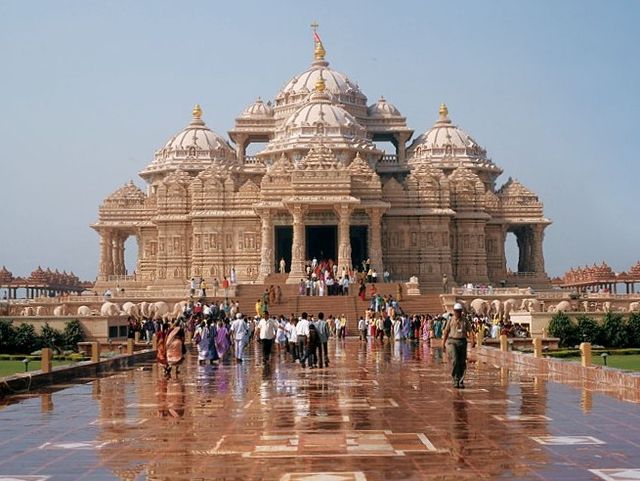
Photo courtesy of Wikipedia.
Akshardham which translates to ‘The Divine Abode of God’ is a place of devotion, purity, and peace, dedicated to Swaminarayan, an 18th-century yogi, and spiritual ascetic. It blends Maharishi Vastu architecture, Hindu spirituality, and Indian traditions into a unique complex of gardens, shrines, sculptures, bodies of water, and a step-well courtyard. Carrera marble from Italy and pink-hued Rajasthani sandstone enhance its elegance. Not to be missed is the exterior plinth mounted by life-like elephant sculptures that tell charming stories from the Panchatantra, an ancient collection of animal fables.

Photo courtesy of Wikipedia.
Allow yourself an entire morning to take it all in. We visited on a weekday morning in October and arrived at opening time which enabled us to fully appreciate the setting, the beauty, and the quietude that envelops the temple before the crowds arrive.
Note: * No photography is permitted.
**At night there are water and light shows.
Top Ten 2.
Hawa Mahal – Jaipur – Rajasthan
Jaipur got its name ‘The Pink City’ from the pinkish-brown color that coats many of the old town’s walls and buildings. The architectural, whimsical, gem of the city is the Hawa Mahal – the Palace of the Winds. Built from red and pink sandstone in 1799 by the grandson of Maharajah Sawai Jai Singh, the founder of the City of Jaipur, it glows a deep shade of pink in the early hours of the morning and the waning hours of daylight.

The Palace, dressed in an elaborate façade of hundreds of lattice-shaped windows resembles a delicate pyramid-shaped birthday cake. The windows were designed to allow the female members of the royal family to observe festivals and life on the street below without being seen. They also served as an efficient air conditioning system providing air circulation in the hot days of summer.

View the palace from the street then explore the interior to peek through the windows at the bustling city below and imagine what it must have felt like to be a female member in the maharajah’s court.
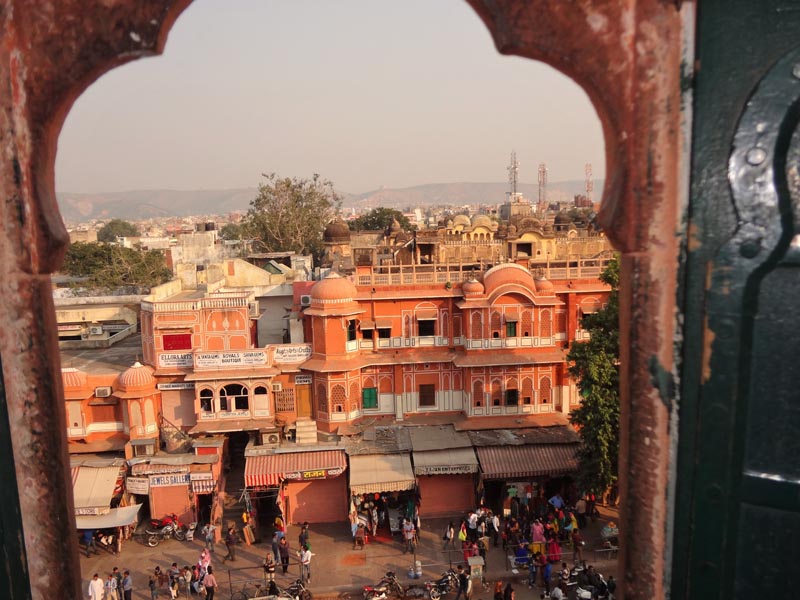
Top Ten 3.
Ajanta Buddhist Caves – Maharashtra State
Ajanta is situated in the vicinity of the ancient trade route on the Deccan Plateau. Between 300 BC and 500 AD, thirty Buddhist caves were carved into the volcanic rock of a semi-circular hillside.

Four of the caves are prayer sanctuaries and the remainder are monasteries. All of them are monolithic and boast expansive interiors. These ancient rock-cut caves were chiseled by hand working from the top down so that the mountain top forms the ceilings, while sturdy columns are purely decorative.

The walls are blanketed in brightly colored paintings that celebrate the life of Prince Gautama, the founder of Buddhism; the mythological Jataka stories relating to the Buddha’s life; and a detailed visual description of the people, their clothing, jewelry, headdresses, animals, and birds.


Monks’ cells puncture the outer walls, and massive columns in a variety of shapes and designs are lined up with geometric precision and symmetry. The skill of the builders is a mind-boggling feat of engineering

The cave openings were carved to allow just enough rays of outdoor natural light to reach the sanctuary where the Buddha statue – always flanked by two male figures and a deer – was housed.

The temples in caves 9 and 10 flaunt spellbinding vaulted ceilings. One marvels at the artistry and ingenuity of their creators.

The Ajanta caves were abandoned after the decline of Buddhism and the resurgence of Hinduism in the 7th century. The forest took over and covered and preserved the sanctuary caves beneath a tangled mass of jungle foliage. In 1819 they were discovered by pure chance when a British officer who was out tiger-hunting, noticed the tip of an archway, which led him to believe that an ancient civilization may have inhabited the area.
In 1951 the Indian Government declared the caves of Ajanta to be a national monument. In 1983 they were designated a Unesco World Heritage site.

Top Ten 4.
Ellora Caves – Maharashtra State
The Ellora caves are a two-hour and forty-five-minute drive from Ajanta. I would not recommend trying to see both on the same day. It can be exhausting and one may experience a case of cave overload, which is a shame as both sites are true Wonders of the World.
As Buddhism began its decline during the mid-6th century, Hinduism was on the rise. Artists and artisans flocked to Ellora which drew the attention of all three religious beliefs: Buddhist, Hindu, and Jain.


While the Buddhist (mid-6th – 7th century) and Jain temples (8th century) are extraordinary, the jewel and unchallenged highlight of Ellora is the Kailasa Hindu Temple.

Kailasa was created to represent the Mountain of Kailasa, the home of the god Shiva in the Himalayas. It is carved from the top-down of a single rock. A multi-level temple designed to mirror the actual Mount Kailasa dominates the central courtyard. The entire structure is decorated with motifs, sculptures, and columns.


Plan on spending an entire morning or afternoon in Ellora with a knowledgeable guide.
Ellora was designated a Unesco World Heritage site in 1983.
Top Ten 5
The Stepwells – Northern India
Stepwells, also known as ‘baoris’, are elaborately decorated water wells unique to India. They were designed and built, particularly in drought-prone areas, to fill and empty in harmony with the change of seasons. Thoughtfully constructed with multiple, layered terraces, they enabled the town residents to access water all year round. Some are square while others are round, octagonal, or L-shaped. The number of entrances also varies depending on the structure and its setting. Rarely has something as basic and as life-sustaining as a water-well been a monumental form of art that also functioned as a place for religious ceremonies, socializing, and a bathing retreat during the hot months of summer. Today there are approximately two thousand remaining stepwells to be found in India. Many are no longer in use but are now treasured and conserved as a unique form of architecture, some are crumbling and neglected, while others are still used by local communities for washing and swimming.

Although Stepwells were built throughout India, the largest concentration of wells is to be found in Northern India. Panna Meena Ka Kund in Jaipur is situated adjacent to the Amber Fort, yet it’s generally overlooked by visitors. This medieval period stepwell is a beautifully symmetric square well, surrounded by ancient temples. Locals who believe that Panna Meena was a brave warrior built the stepwell in his honor.

Panna Meena Ka Kund.
Toorji-Ka-Jhalara is within walking distance of the Sardar market in the Old town of Jodhpur. It fell into disrepair and for decades became a receptacle of debris. Several years ago, the hotel group that owns the property overlooking this ancient gem cleaned and restored it. Today fish can be spotted swimming to and fro and the village children delight in diving from the steps into the well’s deep waters.

Toorji Ka Jhalra.
Rani-Ki-Vav in Patan in the state of Gujarat dates back to the 11th century. Also in central Gujarat, the beautiful theater-like construction of the 15th-century Adalaj-Vav stepwell is adorned with fine filigree work. Often overlooked are two stepwells in the heart of Delhi, the jumping-off point for many tourists’ exploration of India. Agrasen-Ki-Baoli and Rajon-Ki-Baoli.

Adalaj – Vav. Photo courtesy of Ahmedabad Tourism.
Stepwell article contributor: Nomadan. Instagram: pics@nomadan1
Top Ten 6.
Auroville – The Matrimandir – Tamil Nadu.
Auroville is 11 kilometers from the bustling town of Pondicherry. A narrow dirt road branches off from the main highway and snakes its way among tropical date palms, banana, papaya, and mango trees; flowering hibiscus, bougainvillea, and lily ponds.
Auroville was the vision of Mirra Alfassa, who came to Pondicherry in 1914 on a spiritual quest to study with Sri Aurobindo, a yogi who immersed himself in deep meditation while developing theories of enlightenment and spirituality.
Mirra- also known as “the mother” – devoted her life to achieving ‘divine consciousness’. At age sixty she founded Auroville conceived as an international city. A place where people from all nations can live in harmony absent of class, caste, religion, government, or politics; and where the uniqueness of every member nation’s culture and traditions are respected and preserved.

A pathway, dotted with arbors covered in blooming vines, meanders through the lush forest that delivers one to the spiritual heart of Auroville where a humongous, golden, round ball, rests on a plush carpet of green grass the size of a football field. One has the feeling that it had to have arrived from outer space. Known as the Matrimandir, its surface is sculpted to resemble the petals of a flower. It is a place for contemplation and meditation to reach one’s highest level of consciousness.

Spiritual sayings along the flower-lined walkway.

To enter the Matrimandir, one has to reserve well in advance. No ceremonies, verbal prayers, incense, or flowers are allowed inside. A huge crystal ball hanging from its apex shines natural light into the interior. Mirra Alfassa lived well into her nineties. She left the world a gem to be treasured.


Top Ten 7.
Shekhawati – Northern Rajasthan
In the early 19th century, Shekhawati lay at the crossroads of the silk road, where merchants traded in silks, cotton, spices, and opium. As their wealth grew, they built opulent, spacious, havelis. Skilled artists from Jaipur were commissioned to decorate the mansions with colorful frescoes depicting Hindu deities, mythology, and contemporary life.


Soon the Marwari merchants were competing with each other to build the largest, most ostentatious, and beautifully decorated haveli. Every inch of their homes, inside and out, from top to bottom, were adorned with artwork.

These double-story homes graced with grand entryways have carved wooden front doors encased in lavishly hand-painted archways, which open onto an inner courtyard flanked by the living quarters.
In time, Shekhawati earned the reputation as the “largest outdoor gallery in the world.”

Following the colonization of India by the British, shipping ports sprang up in Mumbai, Calcutta, and Chennai, and the wealthy merchants of Shekhawati began migrating to the big cities.
The glory days of Shekhawati were over. The havelis were gradually abandoned, and their beauty faded as neglect set in. The cost of maintenance is exorbitant, and because they are privately owned, there is neither government nor Unesco World Heritage financial aid available.

Today, many havelis are abandoned, locked up, and crumbling; some have a caretaker family who sweeps, cleans, and welcomes visitors; and several are now being salvaged, restored, and turned into small boutique hotels and museums.

Once an elegant haveli. Now in a state of neglect.
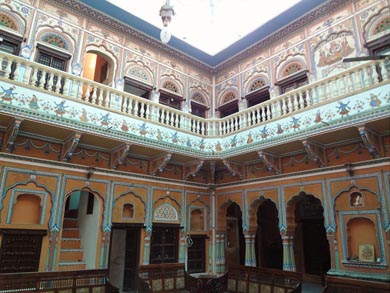
This haveli has been refurbished and is now a small hotel.

This restored haveli is now a museum.

The Desert Resort Mandawa.

Outdoor patio with a view of the landscape. Desert Resort Mandawa.
Top Ten 8.
Khajuraho – Madhya Pradesh State
The temples of Khajuraho were built between 885 AD and 1050 AD by the Chandela dynasty. They were built in the Indo-Aryan architectural style to resemble the Himalayan mountains, a symbol of the god Himavat, father of Ganga, the goddess of the river Ganges. The Ganges is sacred to Hindus and is believed to have the power of purification and forgiveness. Himavat also fathered the goddess Parvati the wife of the god Shiva.
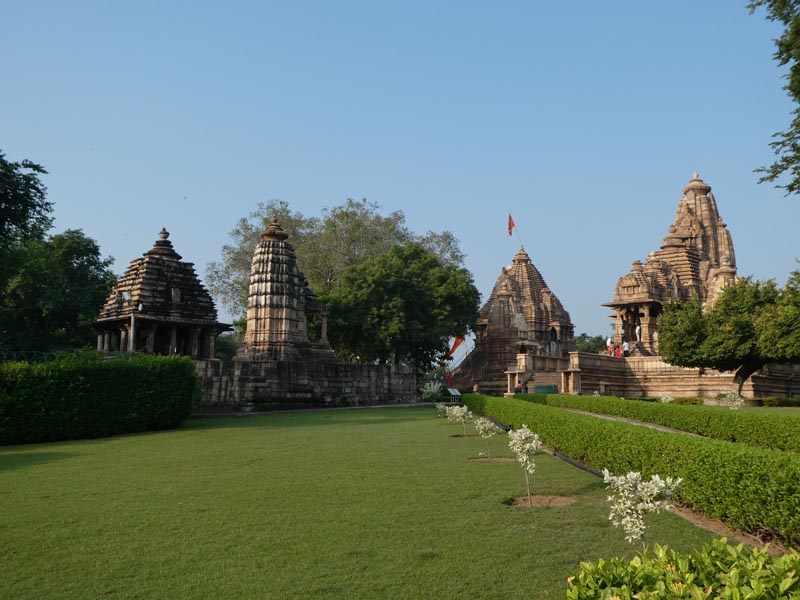
In its heyday, Khajuraho had eighty-five temples. During the Muslim invasion and occupation in the 13th – 18th century, many temples were desecrated and others destroyed. Twenty-five temples survived. The next 800 years saw them abandoned and covered by the jungle until they were rediscovered by British Archaeologist T. S. Burt in 1830.
The sandstone temples rest like pieces of sculpture mounted atop granite bases. Their facades are covered from top to bottom in intricate carvings.


The most impressive and the largest is Kandariya. Nayikas (romantic heroines, female lovers ), deities, and Mithunas (a man and woman in love), as well as mythical creatures, are portrayed. Approximately ten percent of the carvings are erotic art said to represent the height of love and passion.

Men and women in every imaginable position some of which are like advanced yoga poses that required the assistance of their attendants, are portrayed. There have been many theories and interpretations of the sculptures and erotic carvings,however, the truth is buried in the past, which enhances the ongoing fascination and mysticism that draws people to Khajuraho.
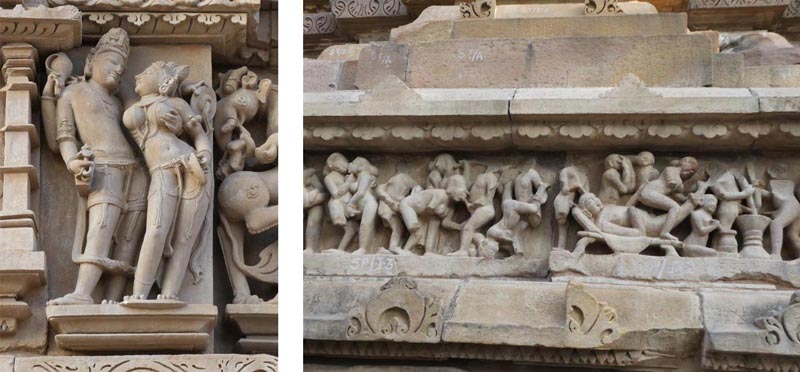

Top Ten 9.
Jantar Mantar Astronomical Center – Jaipur – Rajasthan
Jantar Mantar is the world’s most ancient and best-preserved observatory of its kind. Built in the 18th century by Maharaja Sawai Jai Singh II – a keen student of astronomy – it is akin to an immense outdoor sculpture garden of stone and marble. Not only is each piece fully functional but also a work of art in terms of its curves, angles, materials, colors, and construction.

The monumental instruments are used to tell the time of day to the second; read the position of the planets and the stars, monitor the equinox, and read the signs of the Zodiac, which play an important role in the lives of the people to determine the timing of life’s major events: The timing of a marriage; when to conceive; the right time to purchase a home; start a new business; or embark on a journey.

In these days of high technology, it’s magical to watch the clock ticking on a magnificent piece of sculpture where shadows move across the marble silently measuring seconds, minutes, and hours.

Top Ten 10.
Mamallapuram – Tamil Nadu
Mamallapuram, also known as Mahabalipuram, and affectionately referred to by locals as Mamalla – was a bustling seaport as early as the 1st century. Under the rule of the Pallava dynasty (7th – 9th century) monolithic, monumental shrines were carved out of the granite rock face and covered in detailed, intricate, bas-relief.
Situated on the Bay of Bengal, it is unique not only in its size but in the richness of the carvings.

Begin your tour with a walk up to Krishna’s Butter Ball: A massive boulder, which seems to defy all laws of gravity, balances precariously on a rocky plateau. It would appear that the slightest earth tremor would send it crashing down the hillside flattening everything in its path. Yet for centuries neither earthquakes and tsunamis nor kings and their elephants, have succeeded in budging it.

Arjuna’s Penance, carved out of a single rock the length of a small ship, is said to be the largest bas-relief in the world. It depicts elephants, monkeys, lions, dancing nymphs, and the central figure of Arjuna – one of the five Pandava brothers. It’s a spectacular piece of art and sculpture amazingly preserved.

The Five Rathas, named after the five Pandava brothers and their shared wife Draupadi, rest in a large open sandy space adjacent to the Bay of Bengal. Each one is different. Together they represent the diversity of the Dravidian architecture of the time. Each one is a treasure, from Draupadi Ratha which is the smallest and resembles a village hut, to the Dharmaraja Ratha, which is the tallest, the most elegant, and richest sculpturally.
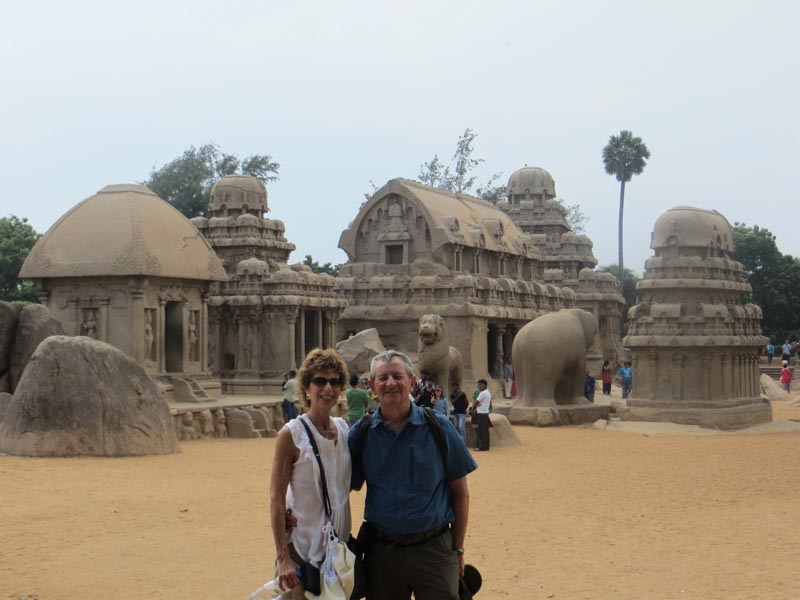
The Five Rathas.

Draupadi Ratha

Dharmaraja Ratha in the foreground, beside Bhima Ratha.
End your tour at the Shore Temple built in the early 8th century to honor Lord Shiva. It was part of a complex of seven temples. The other six, lie buried beneath the sea. In 2004 before a devasting tsunami rolled in – the water receded and for a brief moment, the tip of a submerged temple built of granite was exposed on the ocean floor.

